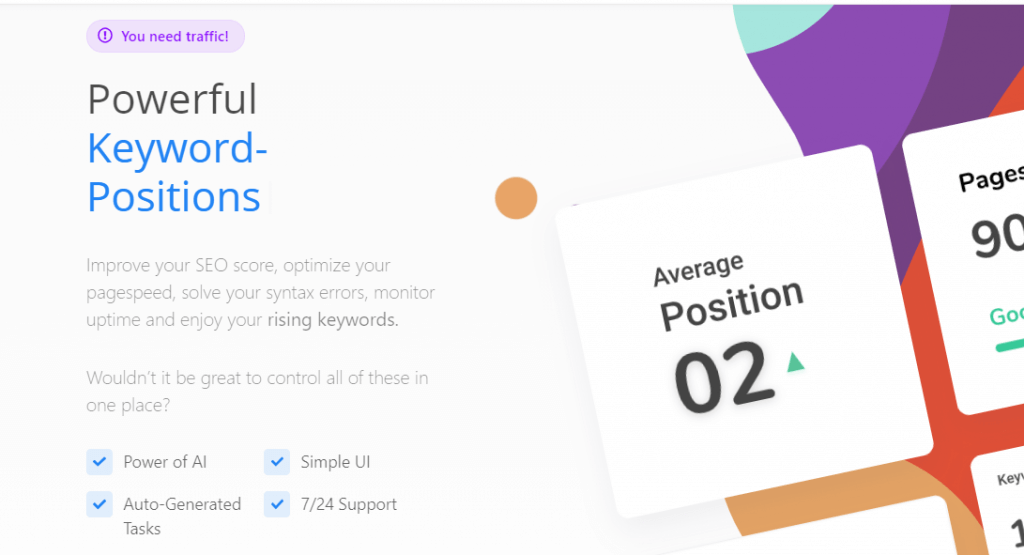SEO Strategy for Blog Sites: How To Optimize Your Blog Website
What exactly does your website have? Until now, we have focused on e-commerce sites while talking about both UX and SEO. However, there is another type of site that appeals to the majority of web traffic in the world: Blog sites! If your website is a blog site and you want to rise step by step with the right SEO strategy accordingly, you are definitely in the right place with Screpy experts!
So, is there such a thing as SEO Strategy for Blog Sites? What strategies should blog sites follow that might allow them to step up more quickly? Where exactly are content sharing and content optimization in this business?

Don’t forget to check the rest of the content to review the answers to all these questions!
Try for free to boost your website traffic!
SEO Strategies To Follow For Your Blog Site – A Step-by-Step Guide!
If you want your blog site to offer a stronger UX and to have higher conversion rates step by step, you have to know how to speak the language of search engines, and you have to be able to present exactly what they are looking for in the easiest and most practical way. -Hey, see our blog post titles ”How Do Search Engines Work?” for more.
Someone who can do both of these and keep their site up-to-date and ‘alive’ can step up, paying attention to a few technical details.

Hey, let’s make a small note before moving on to our topic: By adding your blog sites to Screpy, you can analyze them regularly and track all their details from pagespeed values to SEO scores, uptime moments to keywords rankings. It is time to gain full control of your website!
Here are the seo strategies for the blog site!
Is Your Blog Design SEO-Friendly Enough?
In the context where we talked about UX and SEO, we made this clear: How user experiences what you offer them when they enter your site, something that search engines care highly!
Hey, search engines are not “machines” diving into technical details and elusive calculations. Their goal is to put themselves in the user position while crawling your site and highlight the page that offers them the best experience.

If your blog site is powerful enough, you will get the following results from users:
- The bounce rate of users coming to your site as a result of any query on the SERP will be lower. Because users can find your site navigable, useful, useful, and relevant.
- Increasing the time users spend on your site means they read or watch the call-to-actions and content you offer them. This can help increase conversion rates at the end of the day.
- If you provide a website design that is easy for users to navigate, more pages on your website can be browsed. Search engines care about how many pages the users landing on your site browse. Because the number of pages visited tells the search engines that users encounter a strong performance in terms of UX and find what they are looking for and surf here. This means overall good results.
Image Optimization Is Quite Important
What are the most important values of blog sites? Let’s say right away: Of course the ingredients! As long as the content is readable, understandable, and traceable, they bring great results.

What’s more, it’s the content itself that encourages the user to spend more time on your page, interact and convert.
A study has revealed that among websites that set a blog content strategy, those who use approximately ten or more images in their content get stronger results in terms of UX. According to Orbitmedia’s research, the majority of bloggers, who have achieved strong results in the long term, place great emphasis on the use of visuals in their content.
How To Do Image Optimization?
But how should be these images? Here are the tips for images you can follow for SEO strategy of your blog site:
- If possible, pay attention to the use of original images. This will mean much better results.
- Make sure that your images are understandable and accessible on both desktop and mobile devices. The use of images that can adapt to different device sizes is very important for your SEO score.
- One of the most important things in SEO strategies for blog sites is editing the alt tags of images. Images’ alt tags should be fields containing your main keyword and its semantic versions. This makes it easier for you to appear in Google Images searches and tell Google what is there.
- If possible, choose to add an image description under each image. In this way, you create areas for users with disabilities that screen readers can easily examine and voice. Also, even when the user enters your site but the images have not yet been loaded, they can understand what the images are about and the context becomes clear.
- It is very important that the images have a high resolution, be large enough. In this way, you create a stronger UX. Keep the number of images in your content as much as possible and guide users with images.
- Make sure the images are used in the correct format. Nowadays, the jpeg format is frequently used within the framework of page speed optimization because it creates much less overhead. You can also choose to have your images in this format.
The Best SEO Strategy for Blog Sites: a Detailed Keyword Research
We know what you need to do in order for your blog site to be strong enough and stand out for certain queries on Google: Take advantage of the magic of keywords.
In fact, this issue is directly related to content optimization. Users should see keywords all over the post.

Let’s be clear: The main purpose of using keywords is not actually your visitors. SEO is done for two things:
- To provide a UX-oriented website
- To be able to speak the language of search engine bots to show that the website you offer is UX oriented
Here we use keywords to do the second action. We know that Google no longer searches for keywords as patterns and content. When browsing content, Googlebots generally scans the paragraph and examines the keywords and the flow of the text in it to find out if the content is “what the user is looking for“.
This is exactly why content is the king!
Why is the use of keywords important in content then?
Let’s say:
- The keyword research you will do will give you clues about what details are being searched on related topics and ensure you understand the scope correctly.
- Especially long-tail keywords create stronger SEO scores by increasing your chances of appearing in the SERP, your chances of getting featured snippets, and CTR rates.
- All of the keywords you use attract bots during the Googlebots crawling and match you to relevant queries.
There are many keyword analysis tools you can use to find the right keywords and move you step by step. Semrush, for example, is one of them. Here, you can decide what type of content to include in your content by doing a location-based keyword search.

Also, before starting your content, it may be a good idea to examine which keywords your competitors are producing by focusing on, and to find niche keywords and move through them.
Things To Consider Using Keywords
Screpy allows you to easily track your projects in which keywords and in what rank. This is highly functional. In this way, you can more easily understand which type of content you should prioritize in your blog strategy.
When using keyword in content;
- Do not use excessive keywords. Remember, you don’t want Googlebots to mark your content as spam. The keyword ratio in the content should remain between 1 and 2 percent and should not exceed this range.
- Don’t use keywords stuck in a single domain. A structure that spreads throughout the content and shows that there is a homogeneous distribution of information in the content will bring much stronger results. So pay attention to the general spread of keywords.
- Instead of using a large number of the same keyword, add semantic versions, related keywords, long tail keywords in case of questions and choose to increase your chances of reaching your target audience in this way.
- Use keywords in the image tags of your content, too.
- Do some research based on search volume using Google’s suggested queries and other paid tools.
Internal Links Are Very Valuable To You
The foundation of the SEO strategy for a blog site comes from strengthening the page authority as much as possible through internal linking. The strengthening of the page authorities by feeding each other means that you get excellent results. But the things you need to pay attention to while linking inside the site are really very many. Let’s start to examine if you wish.

- First of all, remember that the anchor text you use while linking should contain keywords associated with the page you are linking to. In this way, you will get a much stronger result.
- When creating links on your page, be careful to do this with content that is truly relevant to that content. Irrelevant content both confuses Google bots and negatively affects the user experience (UX).
- Under each content, leave links to other content that users may like. This both contributes to the on-site link building, makes it easier to navigate within the site and increases the time the user spends on the site.
- All of this means you are an “SEO compatible blog site” for Google. Remember, if there is UX, there is SEO too!
Enable Users to Sign Up for E-Mail Newsletter Subscription
Ask users the following question via various pop-ups or your landing page: Would you like to be notified of new posts?
It is very important that you do this. If you regularly post blog posts, the main thing that will attract users to your website is to be aware of these posts. After all, in a highly complex and crowded internet world, you should not expect people to visit your site using a direct link.

Then let people know by e-mail. In order to do this, it is necessary to convince them to give their e-mails. It may be a good idea to create your landing page with call-to-action slogans for this persuasion.
Remember: The e-mail template you will use to promote your new content in your e-mail newsletter subscription is also very important. It may be a good idea to work with e-mail marketing experts and prepare content with content experts to maximize click, view, and read rates.
Use Social Media to Promote Your Blog Posts Regularly
Imagine chatting about topics similar to your blog posts on social media. Wouldn’t that be great if you could invite people to your post using links in these chats? This has two benefits:

- In fact, you are creating off-site link-building for your site, which increases your popularity and authority.
- In addition, you drive traffic to your site by ensuring your site is discovered by a wider audience. SEO is a powerful tool for search engines, but SERP isn’t the only way to attract audiences. By using alternative methods, you can increase your traffic rates step by step and get better.
Let’s give you a tip: If you want your content to be shared on various social media channels and you want to create popularity through these channels, what you need to do is add social media sharing buttons to the bottom of your posts. With these buttons, you can encourage users to share content with their friends. This will mean a natural and completely effortless link building process.
Remember: Social media is one of the effective ways to get website traffic.
FAQ
How do I optimize my blog for SEO?
Optimize your site by paying attention to the following details:
1. Increase the readability of your content.
2. Make internal and external links in your content.
3. Make sure your content is flawless in terms of title tags such as h1, h2.
4. Make sure to enter completely unique content. If the content is the same as other content on your own site, use canonical links.
5. Perform an accurate audience targeting by doing keyword research.
6. Get the result by regularly analyzing the results and keyword positions of your content.
7. Make sure your site has a strong UX in terms of navigation.
8. Make it easy for you to navigate by using breadcrumbs and similar structures.
9. Get the name placement right.
Which blog platform is best for SEO?
Recently, the blog platforms that give the best results for SEO are listed as WordPress, Drupal, Joomla, Ghost. You can review these digital products, which have powerful editor panels, and choose the one that suits you best.
How often should I blog for SEO?
Up-to-date and frequent sharing is very important on blog sites. Research has revealed that bloggers, who share 3 to 4 content a week, get much better ranking results in the long term. Those who post blog posts every day get the best results. In short, an intense frequency is never a problem unless you use spammy content.
What’s the best day to post a blog?
Generally, in order to stand out and get maximum traffic, you should choose the times when users are most likely to see content by entering your website. Blog posts shared around 11 o’clock in the morning on Monday can get more traffic when looking at the average rates. Research has revealed that bloggers who want to get interactions (eg comments, likes, etc) prefer to post on Saturday.
How many blog posts should I have before going live?
If you want a good SEO score for your blog site, you need to have 5-6 blog posts before making live your website. This number may also vary depending on the theme you use on your pages. Make sure you share enough blog content to keep your theme looking stylish and understandable enough.
How many words should a blog post be for SEO?
In order to create a strong SEO structure in blog content, you can plan a structure between 1000 – 2000 words. 3000+ numbers in full guide themed content can produce extremely powerful results. Of course, the titles used, the content structure, and whether the content answers the basic questions of the users are as important as the length of the content.
What is the best blog length for SEO?
The most up-to-date studies for 2021 revealed that the most optimal content length for SEO is between 1760 and 2400 words. This range is not very strict and may vary depending on the subject.
Which website builder has the best SEO?
The most preferred website building tools in 2021 are Wix, Squarespace, Weebly, GoDaddy. You can make a site by choosing one of the many tools.
Are blogs good for SEO?
Blog sites as well as blog pages of websites can get a higher ranking in search engines when they are updated regularly. In this way, the authority of the website will increase and the possibility of being ranked better in the areas where the website serves will increase.
Which is better Blogger or WordPress for better blog site SEO?
WordPress can be a good option to appeal to a wider audience and take advantage of more advanced features in your blog project. Advanced features in ranking will be more useful in WordPress. Blogger is considered to be a little more out of date compared to WordPress. But if “writing” is the main goal for you and you do not have different goals such as making money on your site and reaching large audiences, you can also choose Blogger.
Test Your Website Issues
You can quickly analyze your site